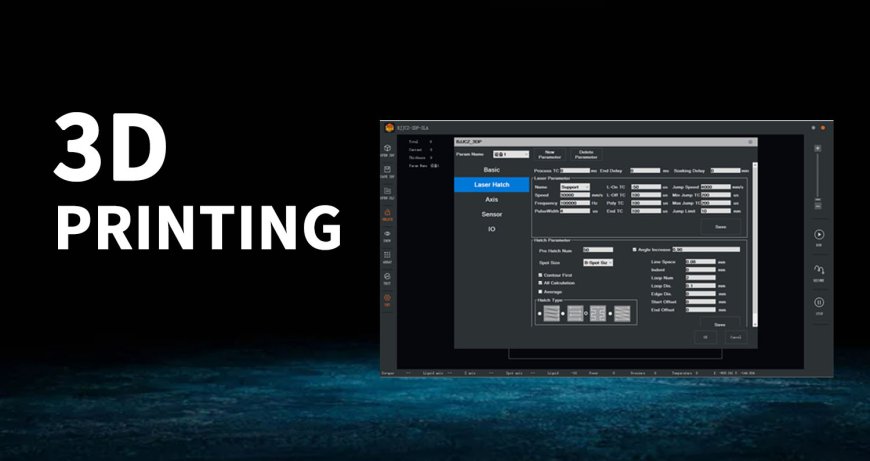Exploring 3D Printing Software and Applications: A Guide for Professionals and Hobbyists
3D Printing Software and Applications

The world of 3D printing has evolved significantly, and one of the most critical components of a successful 3D printing project is the software used to design and manage prints. Whether you're using a filament-based printer or advanced stereolithography (SLA) technology, choosing the right 3D printing software, understanding its applications, and selecting specialized SLA 3D software can make all the difference. This article explores the best software options and highlights the diverse applications of 3D printing.
Why 3D Printing Software Matters
3D printing software serves as the bridge between your digital designs and the physical object you want to create. It includes a wide range of tools and functionalities:
- Designing: Create 3D models from scratch or edit existing ones with CAD software.
- Slicing: Convert your 3D design into layers and generate instructions for the printer.
- Simulation: Preview how the final object will look and function before printing.
- Control: Adjust printing parameters like speed, temperature, and material type.
Choosing the right software is crucial for optimizing print quality, speed, and material usage, so let's look at some top options and applications.
Top 3D Printing Software Options
1. Ultimaker Cura
Ultimaker Cura is a widely popular 3D printing software known for its user-friendly interface and advanced slicing capabilities. It supports a variety of 3D printer models and allows users to adjust a multitude of settings for optimized results.
- Key Features:
- Free and open-source.
- Compatible with most 3D printers.
- Pre-defined material profiles for easy setup.
- Supports both novice and expert modes.
2. Autodesk Fusion 360
Fusion 360 is a professional-grade software that combines 3D modeling and CAD (Computer-Aided Design) with advanced simulation tools. It’s a great choice for engineers, designers, and professionals working on complex projects.
- Key Features:
- Cloud-based collaboration tools.
- Advanced simulation and testing capabilities.
- CAD, CAM, and CAE all integrated in one platform.
- Supports a variety of file formats.
3. Formlabs PreForm
For those using SLA 3D printers, PreForm is a specialized software developed by Formlabs. It is designed to work seamlessly with SLA printers, offering precise control over resin-based printing.
- Key Features:
- Easy-to-use interface with drag-and-drop functions.
- Automatically generates support structures for SLA printing.
- Optimized for different resin types.
- Real-time previews of print layers.
Popular 3D Printer Applications
3D printing has grown beyond simple prototyping and is now used in a variety of industries. Below are some key areas where 3D printer applications are making a significant impact:
1. Prototyping and Product Development
3D printing is a cornerstone of rapid prototyping, allowing companies to create models and test product designs quickly. This reduces the time and cost associated with traditional manufacturing methods.
2. Medical and Dental
From custom prosthetics to dental implants, 3D printing software enables the creation of highly customized medical devices. Materials like biocompatible resins are used for implants, surgical tools, and anatomical models for educational purposes.
3. Art and Design
Artists and designers use 3D printing for creating complex sculptures, jewelry, and fashion items. The precision and flexibility of SLA printing, with specialized SLA 3D software, allow for intricate detailing that traditional methods can't achieve.
4. Aerospace and Automotive
Industries like aerospace and automotive are leveraging 3D printing for producing lightweight, strong parts. Materials such as advanced composites and metals can be printed with specialized printers and software to enhance performance.
5. Education and STEM Learning
Educational institutions are integrating 3D printing into their STEM curriculum, using 3D printing software to teach students about design, engineering, and technology. This hands-on learning approach fosters creativity and technical skills.
SLA 3D Software: A Key Player in Precision Printing
SLA 3D software is specifically designed for stereolithography 3D printing, a technique that uses a UV laser to cure resin layer by layer. The software is critical in achieving the high precision and detail that SLA printing is known for. Here are some top picks:
1. ChiTuBox
ChiTuBox is a powerful slicing software tailored for SLA and DLP (Digital Light Processing) printers. It provides advanced features for support generation, layout, and print optimization.
- Key Features:
- Highly customizable support structures.
- Easy mesh repair tools.
- Advanced slicing options for high-resolution printing.
- Ideal for detailed models and miniatures.
2. Lychee Slicer
Lychee Slicer is a user-friendly SLA/DLP software that simplifies the slicing process while maintaining advanced features for experienced users. It’s compatible with a wide range of SLA printers.
- Key Features:
- One-click support generation.
- Detailed preview of each print layer.
- Cloud-based settings for improved performance.
- Regular updates for the latest printer models.
Tips for Choosing the Right 3D Printing Software
Selecting the right 3D printing software or SLA 3D software can be challenging, so here are some tips to guide your decision:
- Printer Compatibility: Ensure the software supports your specific 3D printer model.
- User Experience: Choose software that matches your skill level—some tools are simple and beginner-friendly, while others are more advanced.
- Material Support: Look for software that has pre-configured settings for various materials, especially if you plan to work with resin or specialized filaments.
- Cost: While some software options are free, others require a subscription or license fee. Consider the software's capabilities against your budget.
- Community and Support: A large user community or reliable customer support can be invaluable for troubleshooting and learning new techniques.
Conclusion
Whether you're a professional engineer or a hobbyist, the right 3D printing software and SLA 3D software can make all the difference in the quality and efficiency of your projects. From rapid prototyping to high-detail art pieces, these tools empower you to bring your ideas to life. Explore the latest software options and applications today to stay ahead in the ever-evolving world of 3D printing.

 jczlaser
jczlaser